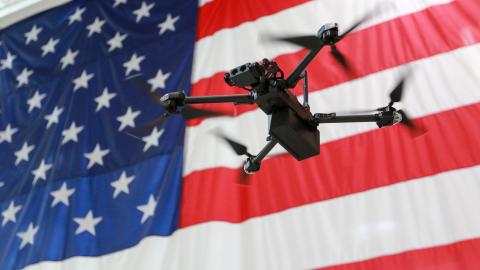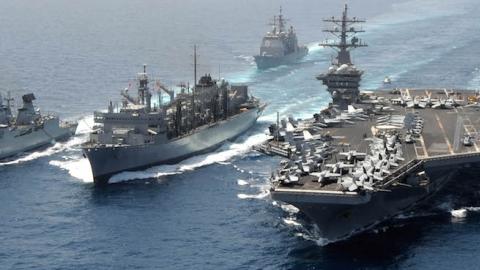As it has been throughout its tenure as the center of Navy force structure, the aircraft carrier’s value and effectiveness are increasingly being challenged. The RAND Corporation released a study last week that (among other things) pointed to a mounting number of Chinese threats to the aircraft carrier and questioned continued U.S. emphasis on carriers in war planning.
Criticisms of the value of the carrier in high-end warfare — the kind that would be waged against China (and the kind studied by RAND) — raise important questions about its utility and effectiveness. These are questions that the Navy has been slow to answer and ineffective where it has tried. The effect is that the rhetorical battlefield has been ceded to carrier critics, who make little attempt to contest the Navy on the ground (or seas) where the Navy prefers to fight. For example, pointing to 54 days of carrier airpower being the nation’s only available strike option against the Islamic State in the summer of 2014 has been the Navy’s recent stock-in-trade answer to those who denigrate the carrier. Yet critics rarely attack the carrier on its ability to respond to crises in the littorals against weaker opponents, as its utility for these sorts of operations is self-evident. Critics prefer to raise questions about the carrier’s effectiveness in conflict with China and its anti-access/area-denial capabilities. There exists a strong and logical argument for the carrier’s role in conflict with China that has not yet been made.
That the Navy’s response to this more effective line of criticism has been muted is not illogical. Rather, it is the wholly foreseeable result of the two important foundational pillars of American national security: civilian control of the military, and jointness. While both pillars add great strength to our national security, their impact paradoxically handcuffs the Navy from making its most effective pro-carrier arguments in the public and unclassified sphere.
First, let’s consider civilian control of the military. It is clear that the Obama administration has pursued a careful policy of attempting to seek common ground with China where our interests are aligned, even as it raises questions about some of China’s more aggressive and less cooperative behaviors in the Western Pacific. There is wisdom in this approach, and time will tell how successful it will be. However, it is clear that talking in a direct and public manner about conventional conflict with China is discouraged. In recent years, Department of Defense officials routinely sought to assure the general public (and China) that the “Air-Sea Battle” concept was not aimed at any one particular country. This played out as evidence mounted of China’s growing focus on neutralizing U.S. advantages in maritime and aerospace power. Also reflective of this approach was an exchange former Chief of Naval Operations Jonathan Greenert had at the U.S. Naval War College “Current Strategy Forum” in June 2014, in which he warned a questioner seeking a dialogue on deterring China that such a discussion might “unnecessarily antagonize” that nation.
If discussions of conventional deterrence are seen as unnecessarily antagonizing, what then are discussions of how to fight and win conventional war with China? And if the discussion of how to fight and win such a war has a central place for the aircraft carrier, suppression of the conversation only reinforces the volume and effectiveness of carrier criticisms that do not recognize such a place.
On October 8, the Hudson Center for American Seapower will release a study entitled “Sharpening the Spear: The Carrier, the Joint Force, and High-End Conflict” at an event on Capitol Hill In this report, my colleagues Timothy Walton, Seth Cropsey, and I make the argument that the Navy cannot make in a public and unclassified form: Conventional war with China is not likely to be deterred, contested, or — most importantly — won without a significant contribution by the nation’s carrier force. The report lays out not only the continuing importance of classic carrier contributions to sea control and scouting, but also argues that in the context of a conventional war with China, carrier-based naval aviation may in fact be the primary surviving element of American tactical airpower to support operations in the Western Pacific. The logic of this claim is what leads to the second roadblock to the Navy making this argument, and that is jointness.
For if naval aviation ends up being the primary method of providing tactical airpower en masse to the U.S. military and allied forces, questions arise about what has happened to U.S. Air Force land-based assets. We found that while the Air Force will continue to provide critical portions of the total airpower the joint force requires, current trends in enemy threats and the absence of meaningful, large-scale Air Force airbase resiliency measures suggest it will be hard-pressed to provide crucial tactical air support forward, where many first island chain bases have been effectively neutralized. Simply put, if you believe the carrier is vulnerable, then you must concede that those air bases are even more vulnerable. The carrier can move and evade, the airbases cannot. Our analysis demonstrates Air Force airpower is essential in terms of not only bombers and tankers, but also fighters; that said, current trends suggest naval airpower may play an increasingly important role that complements Air Force contributions.
Raising and reinforcing this point would open the Navy to charges of service rivalry and insufficient jointness, neither of which is considered career-enhancing these days. Yet thinking about war with China and how it can be waged raises and illuminates a strong case for continuing to build large, nuclear-powered aircraft carriers — ships that provide credible presence and deterrence and that would prove critical to war termination.
In essence, the Navy is prevented by law and custom from providing for wide consumption its most effective line of argument for continuing to build aircraft carriers. And so arguments that denigrate the increased sortie capability of the Ford class over its predecessor — arguments that question whether any future fight would make use of these sorties — go unanswered in the context of where those sorties would make a difference. And arguments that question the size and expense of the Ford while suggesting that smaller, conventionally powered amphibious aviation platforms would be sufficient go unanswered by contextual counterarguments that point to those ships’ meager weapons storage capabilities and the logistics strain such ships would place on an already brittle logistics chain.
This is not an argument against either civilian control of the military or jointness; it is, however, a warning that both contribute to an impoverished debate in which one side is free to raise all manner of threats to the aircraft carrier wielded by China, while the Navy must content itself with generalized statements of value in high-end warfighting and specific historical vignettes against lesser actors. The authors of the Hudson study find this troubling.


















